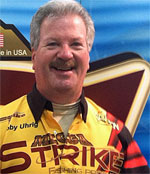MegaStrike’s Uhrig: Diving With Bass
 by Bobby Uhrig, MegaStrike
by Bobby Uhrig, MegaStrike
I’ve been a serious bass fishermen longer than I can remember. Fished everywhere I could, tried every lure I could, read and watched everything I could. But at some point that wasn’t enough for me. I had this feeling that if I could learn more about what bass do in their natural environment, it would help me catch more fish.
So way before I started MegaStrike, I hooked up with one of the world’s most renowned under water photographers, Tim Simos, and embarked on a new chapter of my fishing education: diving with bass.
I’d snorkeled in lakes and ponds over the years, but this time I went out and got my scuba diving certificate. Then Tim and I went and found some clearer waters to dive – so we could watch and learn how fish relate to structure and cover.
I started shallow (just like most bass fishermen would!), swimming in water around the shoreline up to 5 feet deep. Later in the day I ventured out into deeper water – as deep as 40 feet. (In warmer conditions, bass move deeper as the sun rises higher. In early spring, they come shallower as the sun gets higher.)
For largemouths, I noticed that the key to finding them was to stay in the grass. Not only that, the nicest, plushest, greenest grass you could find, the better. Makes sense: The more photosynthesis, the more oxygen produced and the more active the fish could be.
Plus there were baitfish. As we all know, the baitfish use the grass as cover to hide in, and the bass use it as an ambush area to pickoff unsuspecting prey without having to move far.
Keys: Bass Magnets, Staying Put
We also noticed that the bass congregated around objects in weedbeds – for example, stumps, rocks, rockpiles, boulders, brushpiles, laydowns. At the time we called them “bass magnets.”
Before I dove with bass, here’s what I would do when I’d find one of these bass magnets, whether I was fishing for fun or in a tournament: When I’d catch a fish, I’d immediately try to establish a pattern. In other words, if I caught one on a stump, I would quickly go find another stump to try to duplicate my success.
But what I noticed when diving was these bass magnets would usually have multiple bass: More than one! For example, brushpiles or laydowns would have not one, not even five, but at times 25 bass!
So let’s think about this: How many times have you caught a bass in a laydown or other type of “bass magnet,” and immediately went down the bank looking for the same cover to duplicate that pattern. Every fisherman does that.
But all it means is you could have caught the most aggressive fish there. What I do now, after diving with bass, is if I catch one bass on or near a certain magnet, I fish it thoroughly – using different approaches and techniques, as well as different lures. If I catch one with a jig, I will switch up and throw a tube, then a worm or any other bait I think they will hit.
I exhaust every possible vehicle to try to catch other fish that might be there before I move on. I’m not saying stay there all day, but give it some extra time. You might be glad you did. (It’s that old saying: “Never leave fish to find fish.”)
And make sure you fish the thickest, nastiest part of the cover. Just like we all have heard, the dominant fish takes the dominant spot in the cover. I’ve seen it many times diving with bass, and remember: they don’t get big by being stupid.
Don’t Leave Fish to Find Fish!
From diving with bass I learned that fishing from a boat or from shore – above the water – basically gave me a one-dimensional view of what I thought was going on down there. So what I’m trying to tell you in this brief post is that diving with bass gave me a whole new perspective on how to locate bass and how to slow down and fish for fish that we wouldn’t normally think are there.
_____
 Bobby Uhrig is the president and CEO of MegaStrike fish attractant and lures. Bobby has used his decades of bass fishing experience and firsthand observations of how fish feed and strike lures in the wild (not in tanks!) to create fishing lures that just plain work. Learn more at MegaStrike.com.
Bobby Uhrig is the president and CEO of MegaStrike fish attractant and lures. Bobby has used his decades of bass fishing experience and firsthand observations of how fish feed and strike lures in the wild (not in tanks!) to create fishing lures that just plain work. Learn more at MegaStrike.com.
Category: Fishing Tips/Techniques





